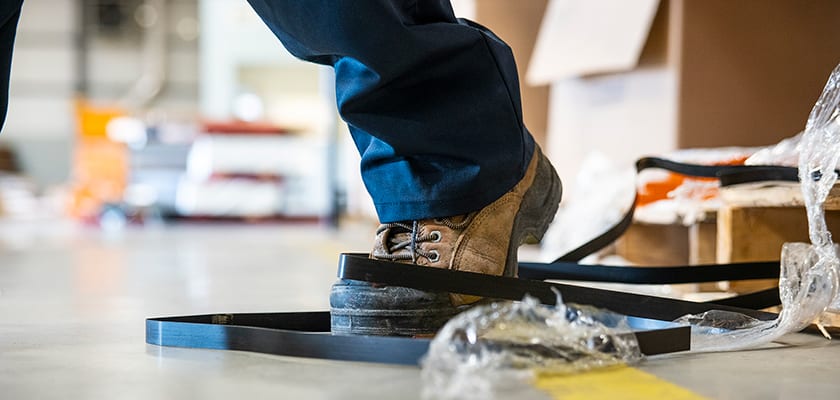Top risks in grocery stores: Protect your workplace and team with these safety resources

Workplace Safety & Prevention Services (WSPS) is a not-for-profit occupational health and safety association committed to ensuring every worker goes home healthy and safe at the end of the day. As your dedicated health and safety association for the grocery industry, we are here to help with resources and support.
The grocery industry and partners are working with WSPS to develop solutions that address the top risks in this sector. In a recent study, this group identified the top 10 risks in the grocery industry. Find out what these risks are and how you can protect your business with these resources below.
Top 10 risks in grocery stores: Resources and training
Click on a hazard to learn more and access health and safety resources and training.
- Musculoskeletal disorders (MSDs) from handling products
- Slips and trips
- Lacerations from equipment (deli slicer, band saw, bread slicer, etc.)
- Workplace stress leading to mental health harm
- Workplace harassment
- Struck by products (working in the back room or receiving area)
- Falls from ladders (A-frame, extension, or greater than 3 steps)
- Workplace violence (assault, robbery)
- Slips or falls from continuous ice buildup from freezers
- Lacerations from hand tools (knives, box cutters, etc.)
Have health and safety questions? We're here to help. Contact us at 1-877-494-9777 or fill out this form and a member of our team will contact you soon.
Musculoskeletal disorders

From receiving to checkout, grocery store workers handle products. Manual material handling involves moving materials and goods by carrying, holding, lifting, and stooping. Factors like repetitive motion, incorrect lifting techniques, fatigue, rushing, and awkward postures can increase the risk of developing Musculoskeletal Disorders (MSDs). MSDs are aches and pains affecting the muscles, tendons, and nerves, and make up almost half of all compensation claims in Ontario. Common MSDs include back pain, carpal tunnel syndrome, and tendonitis. Effective controls for manual material handling can eliminate or reduce these risks, keeping workers safe and boosting your store's productivity.
Resources
- NEW! MSD Prevention - Hiring & Onboarding Tips for Success (guide)
- NEW! Sample Physical Demands Description - Job: Wholesale Distribution Picker (guide)
- Safe lifting: 10 tips and videos of how to lift properly (article)
- How to eliminate 3 hidden causes of musculoskeletal disorders (MSDs) (article)
- Back to basics: Answers to your questions about manual material handling and MSDs (article)
- How to identify and prevent repetitive strain injuries (article)
- MLITSD material handling inspections on now: be prepared (article)
- MLITSD Material Handling Inspections - Frequently Asked Questions
- Safety Tips - Manual Material Handling and Safe Lifting (video series)
- Musculoskeletal Disorders (video)
- MSD Risk Assessment
- MSD Hazards Checklist
- Non-motorized Material Handling Equipment Checklist
- Business in Motion: Managing Material Handling Hazards (guide)
- MSD Prevention Guideline for Ontario (CRE-MSD)
- Safe Lifting Guides - for workers, employers and supervisors
Training and Consulting
- Manual Materials Handling (eCourse, 1 hour)
- Safe Lifting & Manual Materials Handling (1/2 day, online instructor-led training)
- Safe Lifting & Manual Materials Handling for Supervisors (1 hour, online instructor-led training)
- Musculoskeletal Disorders (MSD) Prevention Awareness (1 hour, eCourse)
- Ergonomics Consulting - WSPS experts will work with you and your staff to find personalized, cost-effective solutions to improve your work environment and protect your employees and your bottom-line.
Slips, trips and falls

While they may seem harmless, slips, trips and falls are some of the most common causes of workplace injuries. They can happen in any workplace and may cause injuries like sprains, bruises, broken bones, and concussions.
Having a well-designed workplace and effective safety plans, policies, and programs is important to keep workers safe. Good housekeeping, like cleaning up spills quickly and keeping walkways clear, can help reduce the risk. In walk-in freezers, ice, frost, and condensation can make floors slippery, increasing the risk of falls. Keeping these areas clean and dry by removing ice and using squeegees to direct water into drains is essential. Involving internal teams such as workers and safety committees involved in these safety plans and programs can help ensure they are followed and maintained to prevent slips, trips and falls.
Resources
- Stop slips, trips and falls with these expert tips (article)
- Falls from under 3-metres can be fatal: how to prevent them (article)
- Ladder safety: prevent injuries with this free guideline (article)
- Working at Heights Regulation and Information (article)
- Slips, Trips, and Falls Overview (article)
- Overview: Working at Heights Regulation and Information (article)
- Housekeeping Overview (article)
- Worker resource - Preventing workplace slips, trips and falls (video)
- Safety Check: Mopping Spills Safety (guide)
- Safety Check: Step Ladder Safety (guide)
- Mobile Ladder Stands or Mobile Ladder Platforms (guide)
- Job Aid - Walking and Working Surfaces (guide)
- Job Aid - Good Housekeeping at Work (guide)
- Job Aid - Walk-In Fridges and Freezers (guide)
- Preventing slips, trips, and falls in the workplace (Ministry of Labour, Immigration, Training and Skills Development)
- Preventing Slips, Trips, and Falls in the Workplace Booklet (WorkSafe BC)
Training
- Preventing Falls from Slips and Trips (1 hour, self-paced eCourse)
- Ladder Safety Training (1 hour, self-paced eCourse)
- Working at Heights (an Introduction) (1 hour, self-paced eCourse)
Lacerations

Laceration risks are a significant concern for workers using cutting equipment and sharp tools like slicers and knives. Improper handling, poor maintenance, and lack of training can lead to severe cuts and injuries. For example, slicers can cause deep cuts if fingers or hands touch the blade, and knives can slip and cause accidental cuts if not used properly.
To reduce these risks, it's important to follow safety protocols. Wearing protective gloves can help prevent cuts, and keeping equipment well-maintained can avoid malfunctions. Training on properly using sharp tools and cutting equipment is also essential to keep workers safe.
Resources
- Safety Check: Knife Safety
- Safety Check: Meat Slicer Safety
- Safety Check: Meat Band Saw Safety
- Job Aid – Box Cutters
- Reduce injuries and keep workers safe with these food handling safety tips (article)
Mental Health - Workplace Stress, Violence and Harassment

Poor mental health at work can cause physical symptoms like headaches and psychological issues like depression, fatigue, and anxiety. This can lead to more sick days, trouble concentrating, more accidents, and lower productivity.
A major threat to grocery employees' mental and physical health is violence and harassment. The busy and unpredictable nature of grocery stores can lead to harassment and violence, causing mental stress for workers. Using secure entry systems, surveillance cameras, and well-lit areas can also help prevent violence and harassment.
Creating a healthy and safe workplace with a positive culture, safe environment, employee well-being, psychological safety, and community involvement shows a commitment to workers' overall well-being. This reduces risks and costs and strengthens your business' competitive advantage.
Resources
- Respond to crime and violence in your retail business with this free guide (article)
- Avoid violent encounters at work: 4 expert tips to safely handle a person in distress (article)
- 5 de-escalation tips when responding to agitated customers (article)
- De-escalating high-stress situations at work: 4 stages to aggression, 4 responses (article)
- Hiring a security guard? Here’s what you need to know (article)
- What to do when domestic violence enters your workplace (article)
- 6 expert tips to support people after a traumatic workplace event (article)
- Take a trauma-informed approach to workplace violence and harassment (article)
- Small Biz Bytes: Workplace Violence and Harassment (video)
- WSPS Workplace Violence and Harassment Toolbox (guide)
- Workplace Harassment Policy (template)
- Reporting Form - Workplace Violence and Harassment Procedures (template)
- Workplace Harassment Investigations in Small Businesses: Tips for Employers (guide)
- Leveraging psychological safety to improve worker retention (article)
- Why encouraging vacation increases productivity and job satisfaction (article)
- Do your managers know how to create a psychologically safe workplace? (article)
- Visit the Mental Harm Prevention Roadmap site to create and implement a psychological health and safety strategy at your workplace.
- Guide for managing the risk of fatigue at work (Safe Work Australia)
Training and Consulting
- Violence and Harassment Prevention: Situational Awareness and De-escalation (Online, Instructor-Led Training, 4 hours)
- Workplace Violence & Harassment Training (eCourse)
- Psychological Health and Safety Awareness (eCourse, 20 minutes)
- Psychological Health and Safety for Workers (eCourse, 1 hour)
- Harassment and Violence Prevention for Employees (eCourse, 1 hour)
- Leading for Psychological Safety in Challenging Times (Online Instructor-Led Training, 1 day)
- Workplace Mental Health: How Managers Should Respond (Online Instructor-Led Training, 4 hours)
- Workplace Mental Health: What Health and Safety Committees Should Know (Online Instructor-Led Training, 1 day)
- Reducing Mental Health Stigma in the Workplace (eCourse, 30 minutes)
- Consulting - Connect with WSPS experts to develop a healthy workplace program or a violence, and harassment prevention program.
Struck By Products

Being struck by objects is a major hazard for workers unloading trailers and stocking shelves. This happens when items aren't properly secured or heavy objects are stacked unsafely. During unloading, boxes can shift and fall, causing injuries like bruises, fractures, or concussions. The movement of trailers can make items unstable, increasing the risk when the trailer is opened. Similarly, when stocking shelves, improperly placed items can fall and pose a risk to employees. Heavy or awkwardly shaped items are especially hazardous if not stored correctly.
To reduce these risks, follow proper loading and unloading procedures, use equipment like pallet jacks, and ensure items are securely stacked and stored.
- Prevent Being Hit by Objects in Your Workplace (video)
- Vehicle & Pedestrian Safety (video)
- Worker resources: Safety around forklifts, cars, vans and trucks (video or article)
- Manual Material Handling - Mobile Ladder Stands or Mobile Ladder Platforms checklist
- Pedestrian Safety & Traffic Management (guide)
- Hit by Objects Infographic Poster
- Safety Check: Pallet Jack Safety
- Safety Check: Storage Rack Safety
- Lift Trucks and Other Lifting Devices (article)
- Guide to workplace traffic management (Safe Work Australia)
Training and Consulting
- Inspecting and Maintaining Steel Storage Racks (Online Instructor-Led Training, 1 Day)
- WSPS' consultants can help you identify and assess risks and develop a traffic management and pedestrian safety system tailored to your workplace. Connect with a consultant.
Connect with an expert
If you’re ready to get started, or simply have questions about our services or approach, contact a WSPS specialist to find out more.





